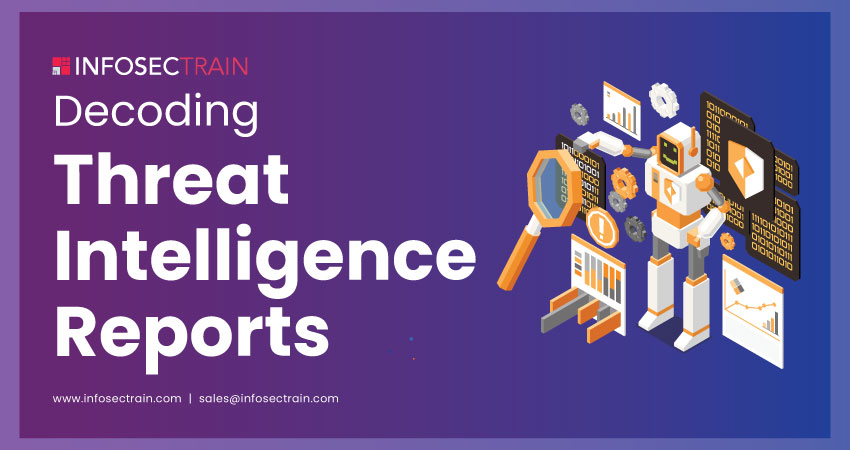Decoding Threat Intelligence Reports
The cybersecurity landscape is a dynamic battleground. Attackers constantly refine their tactics, exploit new vulnerabilities, and target diverse attack surfaces. Organizations face an overwhelming task: staying informed about the latest threats and prioritizing defenses against an ever-evolving attack landscape. It is within this complex environment that threat intelligence reports emerge as a critical tool for security professionals.

What are Threat Intelligence Reports?
Think of threat intelligence reports as curated briefings on the latest cyber threats, vulnerabilities, and attacker tactics. Compiled by security researchers and industry experts, these reports offer valuable insights to help organizations make informed security decisions. Instead of wading through a sea of information, threat intelligence reports provide a filtered view of the most pressing cyber threats. They typically include details on:
- Ongoing Attacks and Breaches: Real-world examples of successful attacks, the targeted sectors, and the impact on victims. This information helps organizations assess their own risk profile and identify potential attack vectors.
- Newly Discovered Vulnerabilities: Information on recently discovered vulnerabilities in popular software, hardware, or operating systems. This allows organizations to prioritize patching and mitigation measures before attackers can exploit these weaknesses.
- Emerging Malware Strains: Updates on new malware variants, their functionality, and the methods they use to infiltrate systems. This helps security teams stay vigilant and adjust their detection and prevention strategies.
- Attacker Trends: Insights into the Tactics, Techniques, and Procedures (TTPs) favored by cybercriminals. Understanding attacker behavior allows organizations to anticipate potential attacks and implement targeted security controls.
Benefits of Threat Intelligence Reports:
By leveraging threat intelligence reports, organizations can reap several benefits:
- Prioritize Security Measures: Identify the most pressing threats facing your industry and focus resources on those vulnerabilities. This approach optimizes resource allocation and ensures your organization is well-equipped to combat the most relevant cyber threats.
- Proactive Defense: Stay informed about new vulnerabilities before they are widely exploited. This allows organizations to proactively patch systems and mitigate risks before attackers can gain a foothold.
- Improved Threat Detection: Gain insights into attacker tactics and how they compromise systems. This knowledge can enhance security tools and strategies to detect and respond to malicious activity more effectively.
- Informed Decision-Making: Threat intelligence reports provide data-driven insights to support informed decision-making. Organizations can leverage this information to optimize their cybersecurity posture, allocate resources efficiently, and invest in the most effective security solutions.
A Look at the Latest Threat Landscape (February 26 – March 3, 2024):
Here’s a breakdown of some of the key cybersecurity developments captured in our latest threat intelligence report:
Vulnerabilities and Patches
- CISA Warns of Exploited Vulnerabilities in Ivanti Products (CVE-2023-46805, CVE-2024-21887, CVE-2024-21893): These vulnerabilities in Ivanti gateways could allow attackers to bypass authentication, manipulate requests, and gain elevated access.
- An Urgent Patch is Needed for ConnectWise ScreenConnect Flaws (CVE-2024-1708, CVE-2024-1709): Exploited by Black Basta and Bl00dy Ransomware, these vulnerabilities grant unauthorized access and control of affected systems.
- Unknown Attacker Targets Millions of Anycubic 3D Printers: A critical remote access vulnerability in Anycubic’s MQTT service is allegedly compromised. The attacker claims control capabilities.
Top Attacks and Breaches
- Healthcare Hit – ALPHV Ransomware Targets UnitedHealth Group Subsidiary (Impacting Change Healthcare): The attack resulted in data theft (6 terabytes) and disruptions to healthcare delivery, including U.S. military facilities.
- Data Breach at Cutout.Pro Exposes 20 Million Users: A cybercriminal leaked user data on a hacking forum, including email addresses, hashed passwords, and IP addresses. Cutout.Pro has not yet addressed the breach publicly.
- Rhysida Ransomware Cripples Lurie Children’s Hospital: The attack disrupted operations, compromised 600GB of sensitive data, and demanded a hefty ransom (60 BTC). Recovery efforts are ongoing.
- Law Firm Houser LLP Data Breach Leaks Personal Information: The breach, discovered in May 2023, exposed Social Security Numbers (SSNs), financial data, and medical records of over 325,000 individuals.
- Walmart Spark Drivers Affected by Credential Stuffing/Phishing Attack: The attack compromised Social Security Numbers (SSNs), driver’s license details, and contact information for over 200 drivers. Walmart has responded with notifications, password resets, and enhanced security measures.
Threat Intelligence Reports
- Rising API Attacks Threaten Organizations Worldwide: A research reports a significant increase in attacks on Web Application Programming Interfaces (APIs). This highlights the expanding attack surface and the need for robust security solutions.
- Iranian Espionage Campaign Targets Middle Eastern Aerospace, Aviation, and Defense: UNC1549, a suspected Iranian threat actor, leverages social engineering, MINIBIKE/MINIBUS malware, and Microsoft Azure for targeted attacks.
- SocGholish WordPress Infections on the Rise: This longstanding campaign uses compromised administrator accounts to distribute Remote Access Trojans disguised as browser updates. Infection rates have doubled year-over-year.
Conclusion
Threat intelligence reports are a crucial resource for navigating the dynamic cybersecurity environment. Integrating these reports into your security strategy enables you to remain abreast of emerging threats, prioritize defenses based on actual attacks, and make informed decisions to protect your organization from cyber threats. Organizations can effectively minimize their cyber risk exposure by staying informed and adopting a multi-layered security approach.
For those looking to enhance their cybersecurity knowledge and skills, InfosecTrain offers a range of courses designed to empower learners to defend against such attacks. From comprehensive cybersecurity training to tailored courses on threat intelligence and incident handling, InfosecTrain provides the expertise needed to navigate today’s cybersecurity challenges effectively.








 1800-843-7890 (India)
1800-843-7890 (India)